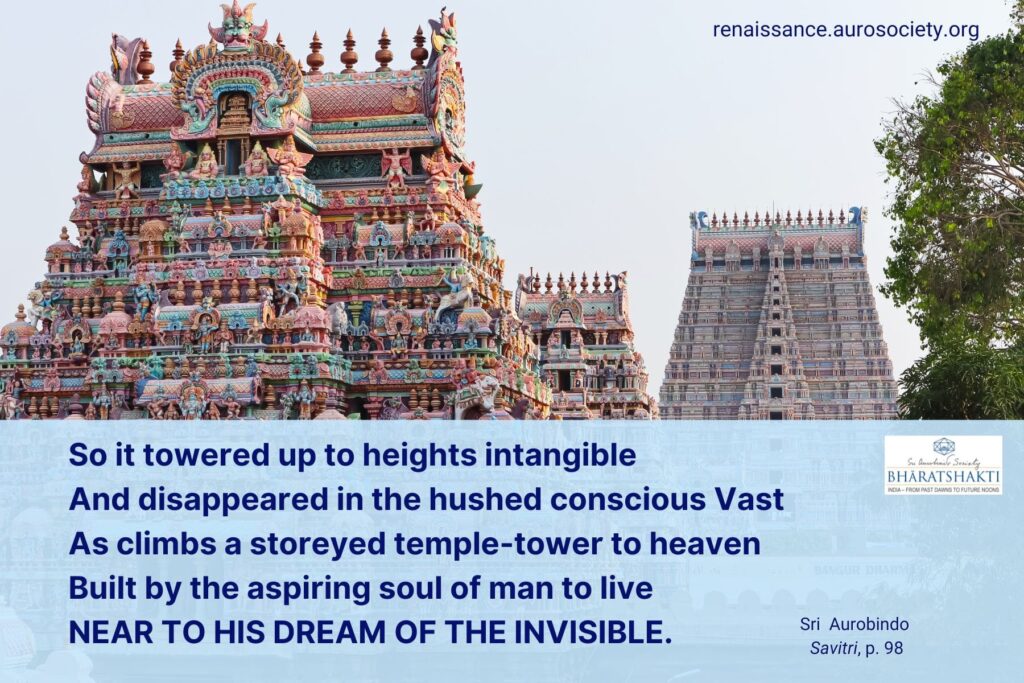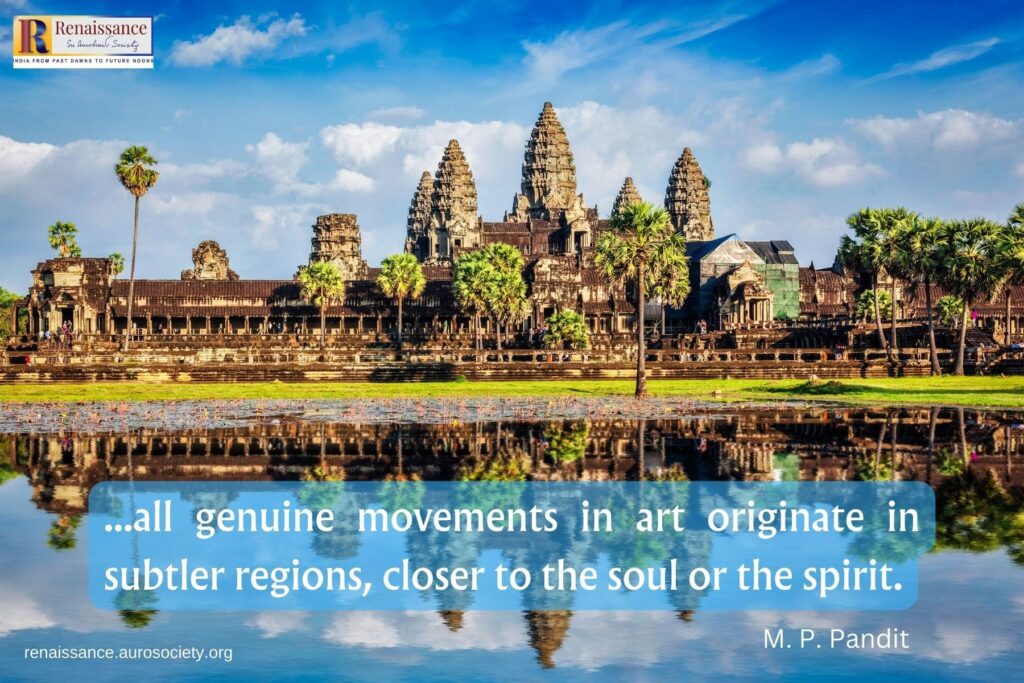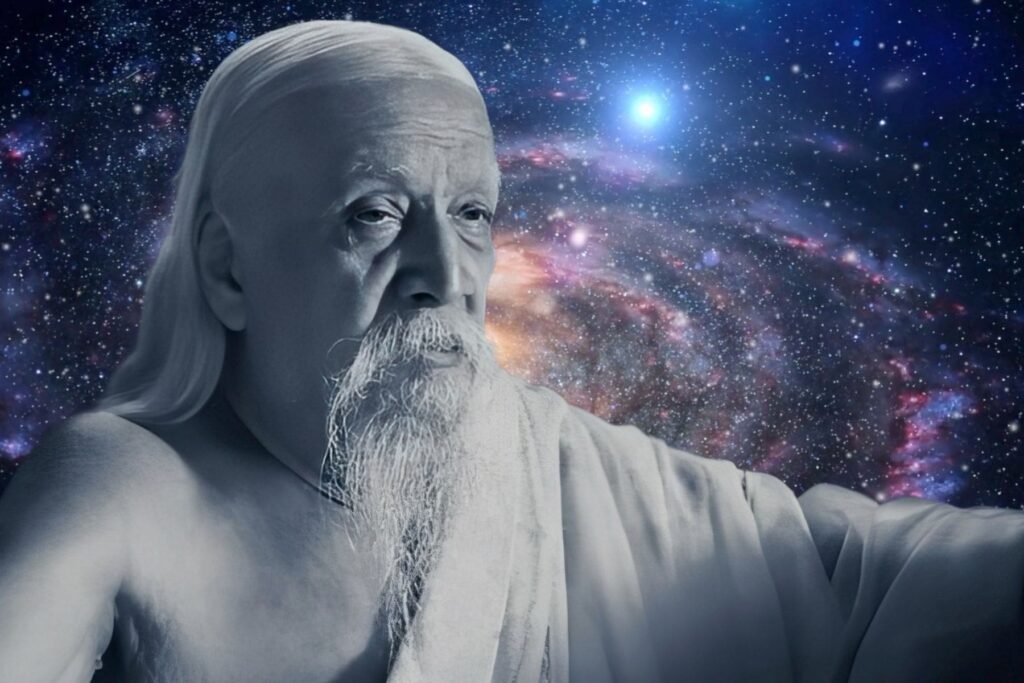Volume V, Issue 8
Author: Georges van Vrekhem
Continued from PART 1
Editor’s Note: In Part 2, the author helps us understand the “world-arrangement” so as to fully understand the avataric mission of Sri Aurobindo.

2. The World-Arrangement
We have seen that Sri Aurobindo said: “Certain conditions have been established for the game.” He also spoke about “the rules of the game,” “the world-arrangement” and “the arrangement of the omnipotent Divine in Nature.” And he said: “All is possible, but all is not licit – except by a recognizable process.” (CWSA, Vol. 35, p. 488) To realize what is the (cosmic) game, the process or world-arrangement, is of immense importance; it is essential to understand Sri Aurobindo’s worldview and his avataric mission.
The ancient understandings of the cosmos all saw its development in time, and therefore the history of humanity, as cyclic. There is a continuous, eternal succession of the four ages or yugas: Gold, Silver, Bronze and Iron, gradually degenerating towards the critical point where all is taken back into its origin (pralaya) and then started again in the same order.
“Lord Vishnu mounted on a white horse, with a drawn scimitar, blazing like a comet will come to end the present Kali Yuga and inaugurate a reign of universal goodness, peace and prosperity, he will renovate the creation with an era of purity or Krita Yuga. The four yugas will then proceed in the same order once again, with similar characteristics, and this process will repeat itself till the final dissolution or Mahapralaya.”
~ V. Ashok, Dasavatar – The Ten Incarnations of Vishnu, p. 292
Sri Aurobindo accepts the essence of the meaning of the cycles and the cycles as such, but in a progressive way, for “the cycles of our evolution” move towards a divine result. We thank his erudition and spiritual knowledge for the coherent, majestic picture of the cosmic manifestation in which fit the partially valid schemes of the religions and mythologies of the past.
The Brahman is twofold: silent, completely absorbed in himself, and active, manifesting himself in a splendour of worlds and beings, for reasons that transcend our understanding and in Hinduism are called his Lila. This effusion of worlds, from the highest formations of Sat-Chit-Ananda down to the lowest of the lower vital, has been explored by Sri Aurobindo and described by him in “The Book of the Traveller of the Worlds,” in his epic Savitri.
As this endless scale of worlds is, each of them, the expression of Existence and Consciousness, it is also the expression of Ananda, and all their beings enjoy therefore perfect satisfaction and happiness as they are, even those of the lower vital which to us become demonic. Sri Aurobindo has called those worlds “typal” because, not possessed of the urge to change, they are non-evolutionary.
However, the characteristics and possibilities of Brahman are infinite, which means that there also eternally existed the possibility of the Divine seeing himself as his own opposite in his negative aspects. As in the Divine seeing means being, immediately Consciousness turned into inconscience, Truth into falsehood, Light into darkness, Bliss into suffering, Life into death. The Great Mother, who is the executive or manifesting Power of the one Divine, and who therefore was responsible for this tragic reversal saw what was happening, and turning to the Supreme she prayed for the remedy and the cure of the evil that had been done.
“Then she was given the command to precipitate her Consciousness into this inconscience, her Love into this suffering, and her Truth into this falsehood. And a greater consciousness, a more total love, a more perfect truth than what had been emanated at first, plunged, so to say, into the horror of Matter in order to awaken in it Consciousness, Love and Truth, and to begin the movement of redemption, which was to bring the material universe back to its supreme origin.”
~ The Mother, CWM, Vol. 9, p. 208
The “movement of redemption” is none other than what we call “evolution,” the slow upward climb on the ladder established as the manifestation of the Divine, and which Sri Aurobindo called “involution.” What in present-day science and common thought is seen as an exclusively material process, is by Sri Aurobindo and the Mother put in its complete, spiritual context. Thanks to them humanity is becoming aware of what is really at stake in the universe: the regaining of the divinity which was at the beginning and which will be at the end – the divine “adventure of consciousness and joy.”
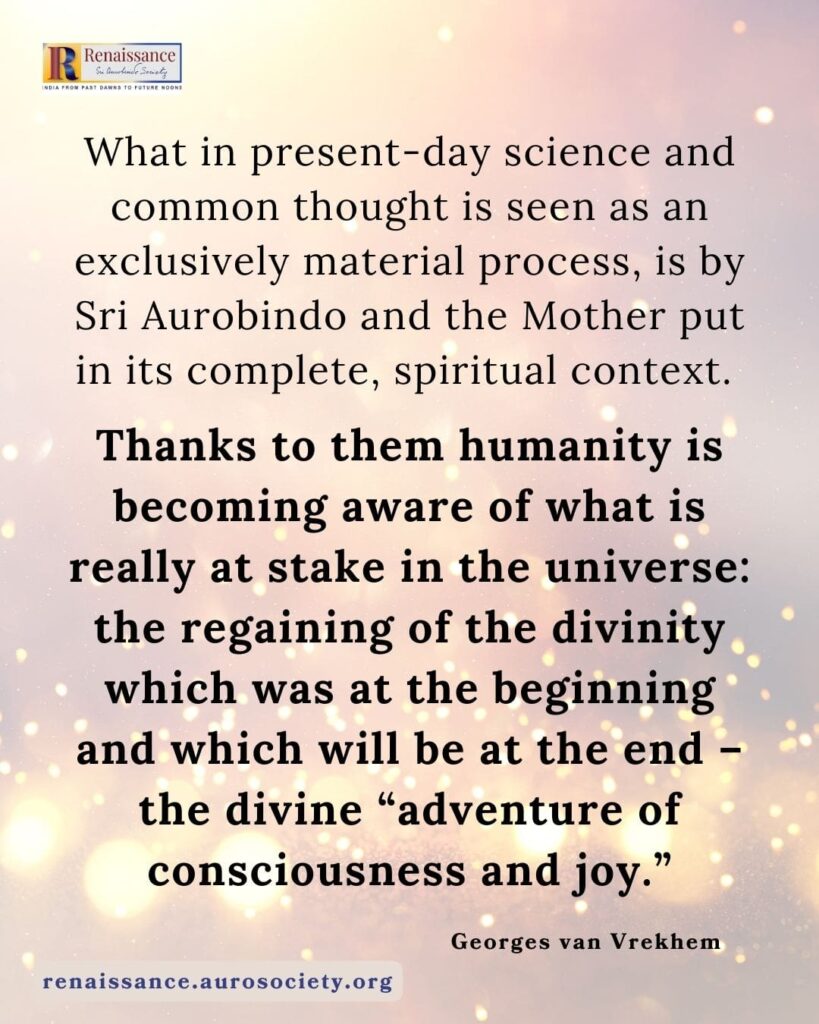
During one of her occult explorations with Théon at Tlemcen, the Mother saw in a cave deep under water a reclining divine figure.
“In fact, this is the origin of all Avatars. He is, so to say, the first universal Avatar who, gradually, has assumed more and more conscious bodies and finally manifested in a kind of recognized line of Beings who have descended directly from the Supreme to perfect this work of preparing the universe so that, through a conscious progression, it may become ready to receive and manifest the supramental Light in its entirety.”
~ CWM, Vol. 9, p. 333
In other words, the divine figure which the Mother saw at the base of the material universe was a personification of the divine Love making the upward climb possible, and to this end incarnating in “Avatars” when the realization of a new level of consciousness became necessary.
We find this confirmed in Sri Aurobindo.
“Are we then to suppose an eternal or continual Avatar himself evolving, we might say, his own mental and physical body according to the needs and the pace of the human evolution and so appearing from age to age, yuge yuge?
“In some such spirit some would interpret the ten incarnations of Vishnu, first in animal forms, then in the animal man, then in the dwarf man-soul, Vamana, the violent Asuric man, Rama of the axe, the divinely-natured man, a greater Rama, the awakened spiritual man, Buddha, and, preceding him in time, but final in place, the complete divine manhood, Krishna, – for the last Avatar, Kalki, only accomplishes the work Krishna began, – he fulfils in power the great struggle which the previous Avatars prepared in all its potentialities.”
~ CWSA, Vol. 19, p. 166
And again:
“The Hindu procession of the ten Avatars is itself, as it were, a parable of evolution.
“First the Fish Avatar, then the amphibian animal between land and water, then the land animal, then the Man-Lion Avatar, bridging man and animal, then man as dwarf, small and undeveloped and physical but containing in himself the godhead and taking possession of existence, then the rajasic, sattwic, nirguna Avatars, leading the human development from the vital rajasic to the sattwic mental man and again the overmental superman.
“Krishna, Buddha and Kalki depict the last three stages, the stages of the spiritual development – Krishna opens the possibility of overmind, Buddha tries to shoot beyond to the supreme liberation but that liberation is still negative, not returning upon earth to complete positively the evolution; Kalki is to correct this by bringing the Kingdom of the Divine upon earth, destroying the opposite Asura forces.
“The progression is striking and unmistakable.”
~ Sri Aurobindo, CWSA, Vol. 28, p. 487
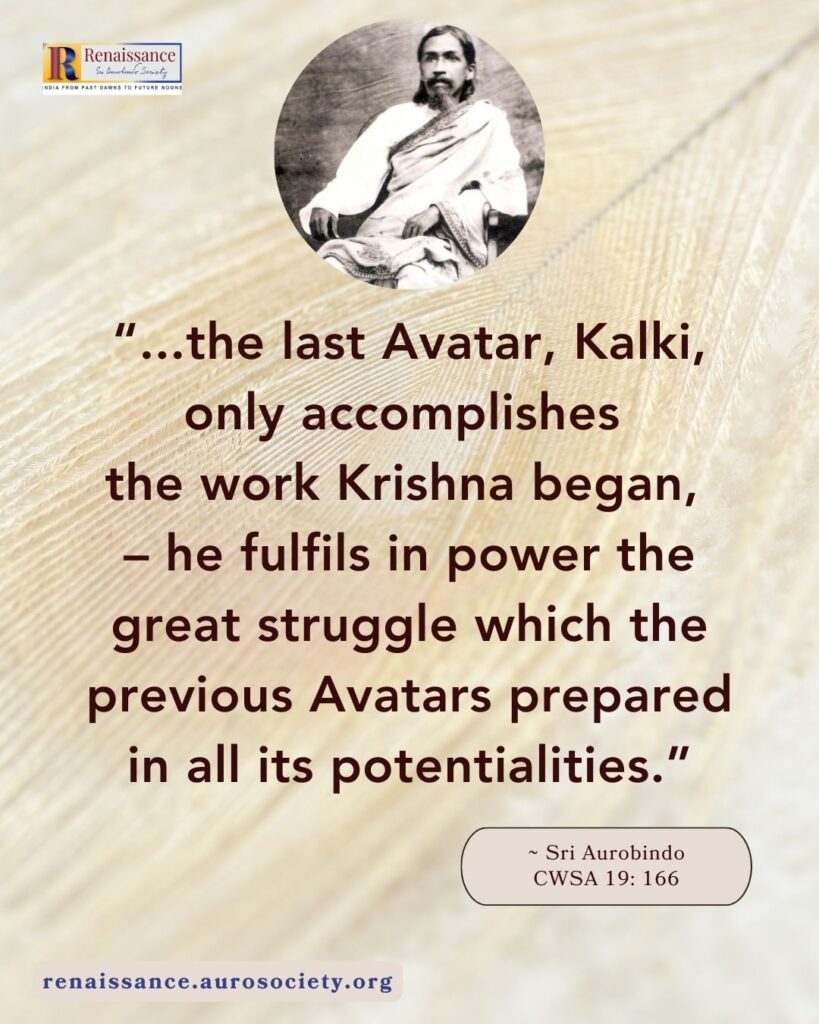
Considering the origin of the Avatars, as above narrated by the Mother and confirmed by Sri Aurobindo, one could argue that the whole of the manifestation is the Avatar of the Divine, who is present in the atom, the cell, the animal. This is still more valid for the human being, who has in him a soul that is a spark of the Divine growing into a completely developed psychic being, and of whom the Upanishad says: tat tvam asi.
When a child asked the Mother: “Mother, are you God?” she answered instantly: “Yes, my child, and so are you.” Sri Aurobindo wrote in Essays on the Gita: “The divine manifestation of a Christ, Krishna, Buddha in external humanity has for its inner truth the same manifestation of the eternal Avatar within in our own inner humanity.” And he wrote in a letter: “If [the Avatar] has something behind him which emerges always out of the coverings, it is the same thing in essence, even if greater in degree, that is behind others – and it is to awaken that that he is there.”
But, obviously, there is also an enormous difference between the human and the divine, which Sri Aurobindo explains as follows: “Now it is notable that with a slight but important variation of language the Gita describes in the same way both the action of the Divine in bringing about the ordinary birth of creatures and his action in his birth as the Avatar. … In both cases Maya is the means of the creation or manifestation,” but in the divine birth the Avatar is conscious, and in the ordinary, multiple birth the “Avatar” is not conscious.
“[The Avatar] is the manifestation from above of that which we have to develop from below; it is the descent of God into that divine birth of the human being into which we mortal creatures must climb; it is the attracting divine example given by God to man in the very type and form and perfected model of our human existence.”
~ CWSA, Vol. 19, pp. 155-157
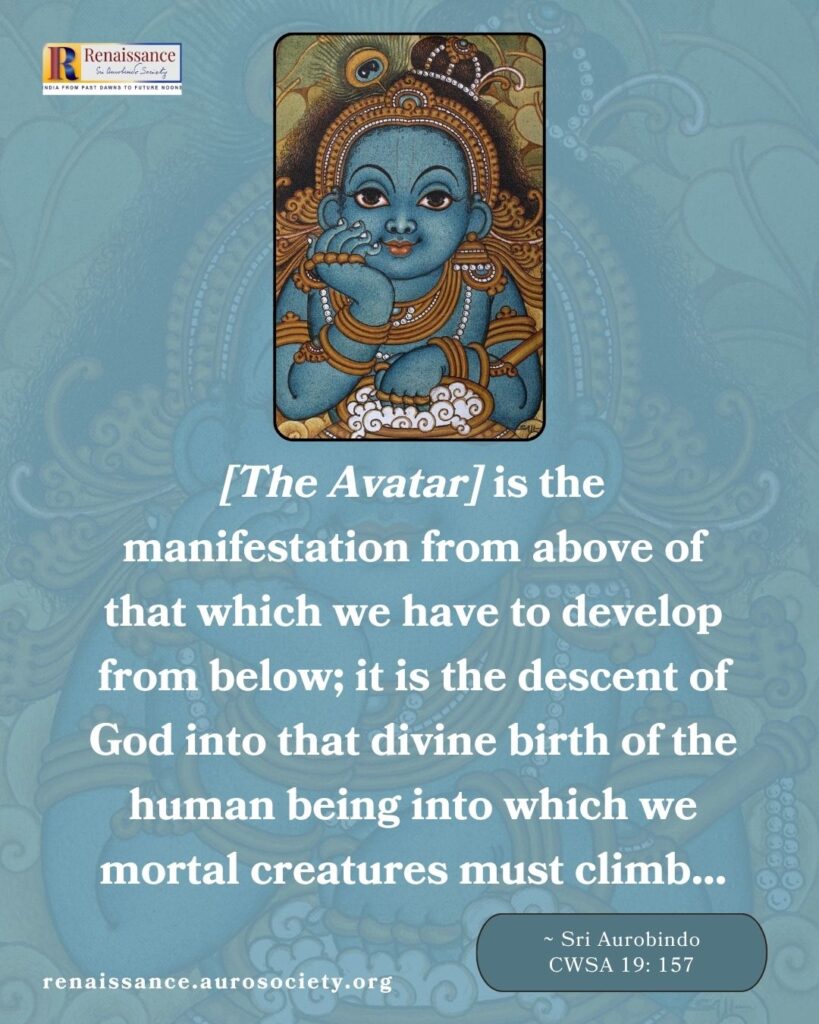
The “something essential in the history of the earth and its races” can only be done by the Avatar if he takes upon him the burden of humanity. Hence the superhuman tapasya and suffering for which some Avatars are exemplary, and which is so often misinterpreted (as we have seen before). For if the Avatar is God, how can he suffer?
The double nature of the Avatar, at the same time consciously divine and fully human, is indeed a great mystery, as great as the mystery of the manifestation. It is, as Sri Aurobindo wrote in The Riddle of this World, a suprarational fact our mind cannot grasp and which therefore has led to endless speculation and controversy in East and West.
Sri Aurobindo’s testimony to this point is quite clear and deeply moving.
“When the Divine descends, he takes upon himself the burden of humanity in order to exceed it – he becomes human in order to show humanity how to become Divine.”
~ CWSA, Vol. 28, p. 473
“I have borne any attack which human beings have borne, otherwise I would be unable to assure anybody ‘This too can be conquered.’ At least I would have no right to say so. … The Divine when he takes on the burden of terrestrial nature, takes it fully, sincerely and without any conjuring tricks or pretence.”
~ CWSA, Vol. 35, p. 418
“No, it is not with the Empyrean that I am busy, I wish it were. It is rather with the opposite of things; it is in the Abyss that I have to plunge to build a bridge between the two. But that too is necessary for my work and one has to face it.”
~ ibid., p. 360
“It is only divine Love which can bear the burden I have to bear, that all have to bear who have sacrificed everything else to the one aim of uplifting the earth out of its darkness towards the Divine.”
~ ibid., p. 46
“Anyone who wants to change earth-nature must first accept it in order to change it. To quote from an unpublished poem of my own:
He who would bring the heavens here
~ ibid., p. 284
Must descend himself into clay
And the burden of earthly nature bear
And tread the dolorous way.
Sri Aurobindo is quoting here for the first time a quatrain from that marvellous poem of his “A God’s Labour”, which could also be called “The Avatar’s Song”.
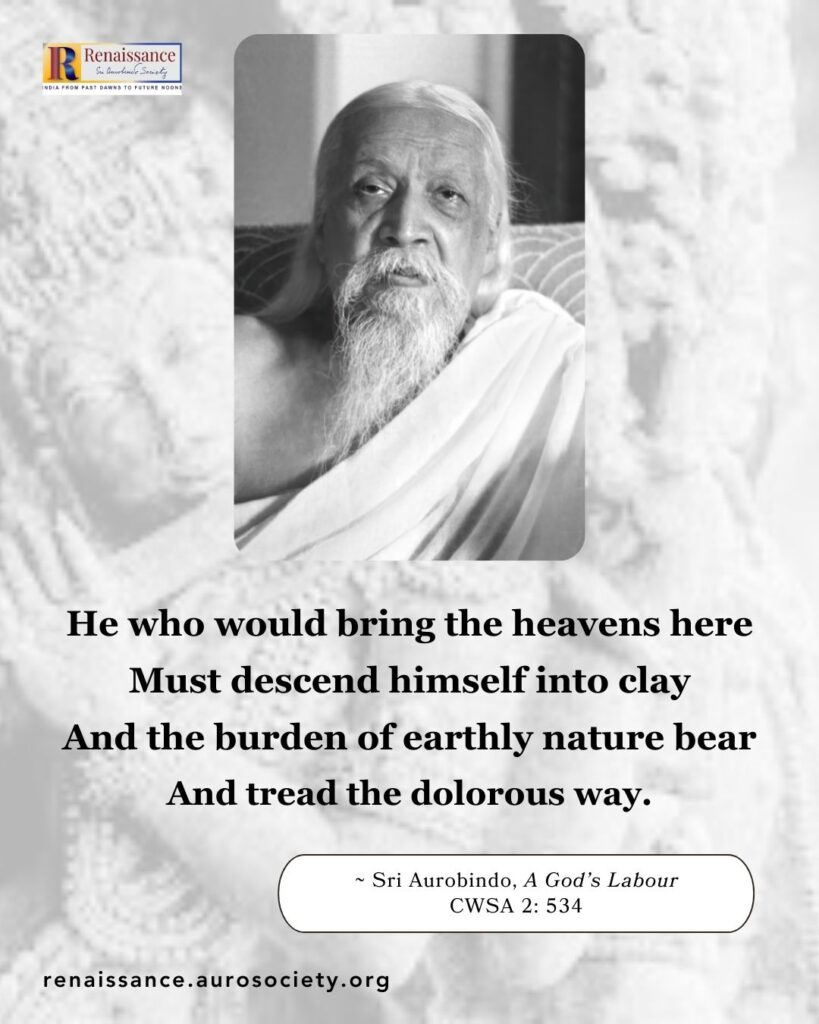
Some of the Mother’s suffering during her last years is abundantly illustrated in The Mother’s Agenda, and partly still alive in the memory of the persons who were physically near to her or to whom it was given to approach her at the time.
In Savitri, the Avatar’s epic, there are many lines evoking the burden he has to bear. For instance:
Mortality bears ill the eternal’s touch…
It sullies with its mire heaven’s messengers …
It meets the sons of God with death and pain.…
The cross their payment for the crown they gave…
He who would save the race must share its pain…
Heaven’s riches they bring, their sufferings count the price…
The Eternal suffers in a human form…
The Creator bears the law of pain and death…
~ Sri Aurobindo: Savitri
CONTINUED IN PART 3
~ Design: Beloo Mehra

